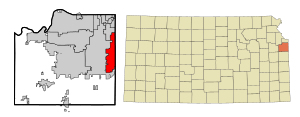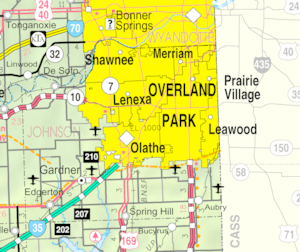Leawood, Kansas facts for kids
Quick facts for kids
Leawood, Kansas
|
|
|---|---|

Location within Johnson County and Kansas
|
|

|
|
| Country | United States |
| State | Kansas |
| County | Johnson |
| Founded | 1920s |
| Incorporated | 1948 |
| Named for | Oscar Lee |
| Area | |
| • Total | 15.21 sq mi (39.38 km2) |
| • Land | 15.11 sq mi (39.12 km2) |
| • Water | 0.10 sq mi (0.26 km2) |
| Elevation | 958 ft (292 m) |
| Population
(2020)
|
|
| • Total | 33,902 |
| • Density | 2,228.9/sq mi (860.89/km2) |
| Time zone | UTC-6 (CST) |
| • Summer (DST) | UTC-5 (CDT) |
| ZIP code |
66206, 66207, 66209, 66211, 66224
|
| Area code | 913 |
| FIPS code | 20-39075 |
| GNIS ID | 485611 |
Leawood (/ˈliːwʊd/) is a city in Johnson County, Kansas, United States, and is part of the Kansas City metropolitan area. As of the 2020 census, the population of the city was 33,902.
Contents
History
19th century
After the 1803 Louisiana Purchase, the area east of present-day Leawood opened for settlement. The Santa Fe Trail which ran through the area also contributed to the development of the area. The Border Ruffian War (1855-1857), part of a larger conflict known as Bleeding Kansas, damaged the local economy as pro-slavery activists from the slave state of Missouri attacked settlers, traders, and those traveling along the Santa Fe Trail. Conditions improved with the founding of Oxford, Kansas, the predecessor of Leawood. The township was destroyed by the American Civil War, and there was little left by 1865.
Leawood was named for Oscar G. Lee, the original land owner of the town site.
20th century
Modern Leawood was established in the 1920s, after Oscar G. Lee, a retired police chief from Oklahoma, moved to Johnson County. He supervised the construction of Lee Boulevard for public use.
In 1948, a housing development by the Kroh Brothers led to the incorporation as a city. On November 30, 1948, Leawood became a city of the third class with a population of less than 2,000. By 1959, it had become a city of the second class. As of 2014[update], it is a city of the first class with approximately 32,800 residents.
As of 2015[update], it was one of the Kansas City metropolitan area's wealthiest suburbs, alongside Mission Hills, Kansas, the Country Club Plaza neighborhood, and Olathe, Kansas. Particularly the neighborhoods of Hallbrook, Mission Hill Estates, and Tuscany Reserve were all rated in the top 1%, according to a widely cited research professor.
Covenants
The developers of Leawood, the Kroh Brothers (Clifford E. Kroh, Jr., and brother John A. Kroh, Sr.) and their father Clifford E. Kroh, Sr., emulated Kansas City urban planner and real estate developer J. C. Nichols, if not competed and attempted to eclipse him. Nichols developed neighborhoods defined by “large lots, curvilinear streets, uniform architecture, extensive deed restrictions, and homes associations,” according to “Race, Real Estate, And Uneven Development; The Kansas City Experience, 1900-2000” by Kevin Fox Gotham.
The Kroh Brothers for years used restrictive covenants for homeowners similar to those developed by J. C. Nichols, which have come under increasing scrutiny since the George Floyd Protests of 2020.
For example, on April 4, 1945, John A. Kroh Sr., filed the following language for a subdivision called Leawood Estates: “None of said lots or portions of lots shall ever be sold, conveyed, transferred, devised, leased or rented to or used, owned or occupied by any person of Negro blood or by any person who is more than one-fourth of the Semitic race, blood, origin, or extraction, including without limitation in said designation, Armenians, Jews, Hebrews, Turks, Persians, Syrians, and Arabians, excluding, however, from the application of this paragraph partial occupancy by bona fide domestic servants employed thereon.”
The Kroh Brothers diversified into shopping malls and office buildings, and developed the original Ward Parkway Shopping Center. Their properties stretched across the country, with more than 100 developments in 13 states. The firm failed in a high-profile bankruptcy in 1987. Clifford Kroh’s grandsons, John A. Kroh Jr. and George P. Kroh, both served time in prison for bank fraud and conspiracy.
Geography
According to the United States Census Bureau, the city has a total area of 15.16 square miles (39.26 km2), of which, 15.06 square miles (39.01 km2) of it is land and 0.10 square miles (0.26 km2) is water.
The city is bordered on three sides by the cities of Overland Park and Prairie Village, Kansas and on the fourth by Kansas City, Missouri. The city's land area is approximately 75% developed and growth is expected to continue in the future.
Demographics
| Historical population | |||
|---|---|---|---|
| Census | Pop. | %± | |
| 1950 | 1,167 | — | |
| 1960 | 7,466 | 539.8% | |
| 1970 | 10,349 | 38.6% | |
| 1980 | 13,360 | 29.1% | |
| 1990 | 19,693 | 47.4% | |
| 2000 | 27,656 | 40.4% | |
| 2010 | 31,867 | 15.2% | |
| 2020 | 33,902 | 6.4% | |
| U.S. Decennial Census 2010-2020 |
|||
2020 census
The 2020 United States census counted 33,902 people, 12,742 households, and 9,974 families in Leawood. The population density was 2,244.3 per square mile (866.5/km2). There were 13,484 housing units at an average density of 892.6 per square mile (344.6/km2). The racial makeup was 86.47% (29,316) white or European American (85.58% non-Hispanic white), 1.51% (512) black or African-American, 0.19% (64) Native American or Alaska Native, 5.09% (1,724) Asian, 0.02% (7) Pacific Islander or Native Hawaiian, 0.67% (227) from other races, and 6.05% (2,052) from two or more races. Hispanic or Latino of any race was 3.21% (1,088) of the population.
Of the 12,742 households, 33.2% had children under the age of 18; 70.9% were married couples living together; 17.8% had a female householder with no spouse or partner present. 19.4% of households consisted of individuals and 11.3% had someone living alone who was 65 years of age or older. The average household size was 2.6 and the average family size was 3.0. The percent of those with a bachelor's degree or higher was estimated to be 57.9% of the population.
24.0% of the population was under the age of 18, 6.6% from 18 to 24, 17.5% from 25 to 44, 29.4% from 45 to 64, and 22.4% who were 65 years of age or older. The median age was 46.5 years. For every 100 females, there were 106.1 males. For every 100 females ages 18 and older, there were 109.7 males.
The 2016-2020 5-year American Community Survey estimates show that the median household income was $156,538 (with a margin of error of +/- $9,441) and the median family income was $194,974 (+/- $22,055). Males had a median income of $116,151 (+/- $13,915) versus $46,187 (+/- $8,762) for females. The median income for those above 16 years old was $76,032 (+/- $4,591). Approximately, 1.0% of families and 1.4% of the population were below the poverty line, including 1.1% of those under the age of 18 and 1.8% of those ages 65 or over.
2010 census
As of the census of 2010, there were 31,867 people, 11,781 households, and 9,367 families living in the city. The population density was 2,116.0 inhabitants per square mile (817.0/km2). There were 12,384 housing units at an average density of 822.3 per square mile (317.5/km2). The racial makeup of the city was 92.3% White, 1.9% African American, 0.1% Native American, 3.8% Asian, 0.4% from other races, and 1.4% from two or more races. Hispanic or Latino of any race were 2.2% of the population.
There were 11,781 households, of which 38.0% had children under the age of 18 living with them, 72.7% were married couples living together, 4.8% had a female householder with no husband present, 2.0% had a male householder with no wife present, and 20.5% were non-families. 18.1% of all households were made up of individuals, and 9.6% had someone living alone who was 65 years of age or older. The average household size was 2.70 and the average family size was 3.09.
The median age in the city was 44.7 years. 28.1% of residents were under the age of 18; 4.3% were between the ages of 18 and 24; 18% were from 25 to 44; 34.3% were from 45 to 64; and 15.3% were 65 years of age or older. The gender makeup of the city was 48.5% male and 51.5% female.
The city has become more Democratic in voting since 2016, going from majority conservative to a reliably swing district with near parity in party identification and fundraising. The city is evenly divided 50/50 Democratic-Republican.
Religion
Leawood is home to the main campus of the United Methodist Church of the Resurrection, which is the largest church in the Kansas City Metropolitan Area and the largest Methodist church in the country with 22,000 members and an average weekly attendance of 13,600. In 2017, one of the world's largest stained glass works, costing $3.4 million, was established as part of the church's building, depicting stories of Jesus and Martin Luther King Jr.
Leawood is also home to three Catholic parishes: Church of the Nativity, Curé of Ars and St. Michael the Archangel.
Economy
Top employers
According to Leawood's 2017 Comprehensive Annual Financial Report, the top employers in the city were:
| # | Employer | # of Employees |
|---|---|---|
| 1 | AMC Theatres Support Center | 450 |
| 2 | Reece & Nichols | 415 |
| 3 | American Academy of Family Physicians | 362 |
| 4 | Blue Valley Unified School District | 346 |
| 5 | Select Quote | Less Than 50 (2024 Layoffs) |
| 6 | City of Leawood | 256 |
| 7 | Murphy-Hoffman Company | 250 |
| 8 | Nueterra Holdings Company | 184 |
| 9 | DEMDACO | 150 |
| 10 | Bukaty Companies | 120 |
Shopping centers
Town Center Plaza is home to a number of upscale stores with few or no other locations in the Kansas City area.
Education
Schools
Two public school districts serve Leawood -- Shawnee Mission School District and Blue Valley USD 229.
Libraries
The Johnson County Library serves the residents of Leawood.
In June 2014, Leawood city officials shut down a Little Free Library due to city ordinance prohibiting free-standing structures in the front yards of residential homes. The family of the 9-year-old boy who built the structure created a Facebook page to support amendment of Leawood's city code. Another resident of the city who erected a Little Free Library was threatened with a $25 fine. There are discussions among the city's residents in working with the city to amend its code regarding free-standing structures in residents' front yards.
Notable people
Notable individuals who were born in and/or have lived in Leawood include Saturday Night Live comedian Heidi Gardner, co-founder of Garmin Corporation Min Kao, romance novelist Julie Garwood, U.S. Representative from Missouri Karen McCarthy, baseball pitcher Dan Quisenberry, founder of Hallmark Cards Joyce Clyde Hall, and tight end for Kansas City Chiefs Travis Kelce.
Sister cities
See also
 In Spanish: Leawood (Kansas) para niños
In Spanish: Leawood (Kansas) para niños

